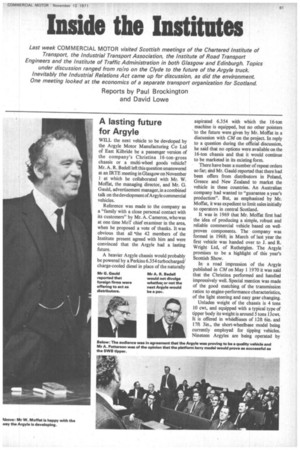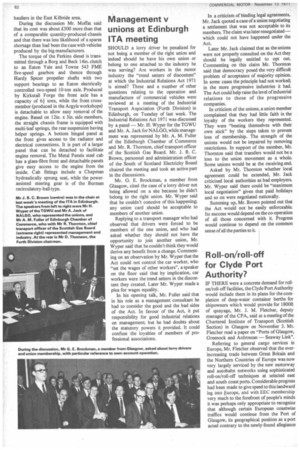Inside the Institutes
Page 63

Page 64

If you've noticed an error in this article please click here to report it so we can fix it.
Last week COMMERCIAL MOTOR visited Scottish meetings of the Chartered Institute of Transport, the Industrial Transport Association, the Institute of Road Transport Engineers and the Institute of Traffic Administration in both Glasgow and Edinburgh. Topics under discussion ranged from rolro on the Clyde to the future of the Argyle truck. Inevitably the Industrial Relations Act came up for discussion, as did the environment. One meeting looked at the economics of a separate transport organization for Scotland.
Reports by Paul Brockington and David Lowe
A lasting future for Argyle
WILL the next vehicle to be developed by the Argyle Motor Manufacturing Co Ltd of East Kilbride be a passenger version of the company's Christina 16-ton-gross chassis or a multi-wheel goods vehicle? Mr. A. R. Bedell left this question unanswered at an IRTE meeting in Glasgow on November 1 at which he collaborated with Mr. W. Moffat, the managing director, and Mr. G. Gauld, advertisement manager, in a combined talk on the development of A rgy le commercial vehicles.
Reference was made to the company as a "family with a close personal contact with its customers" by Mr. A. Cameron, who was at one time MoT chief examiner in the area, when he proposed a vote of thanks. It was obvious that all the 42 members of the Institute present agreed with him and were convinced that the Argyle had a lasting future.
A heavier Argyle chassis would probably be powered by a Perkins 6.354 turbocharged/ charge-cooled diesel in place of the naturally aspirated 6.354 with which the 16-ton machine is equipped, but no other pointers to the future were given by Mr. Moffat in a discussion with CM on the project. In reply to a question during the official discussion, he said that no options were available on the 16-ton chassis and that it would continue to be marketed in its existing form.
There have been a number of repeat orders so far; and Mr. Gauld reported that there had been offers from distributors in Poland, Greece and New Zealand to market the vehicle in these countries. An Australian company had wanted to "guarantee a year's production". But, as emphasized by Mr. Moffat, it was expedient to limit sales initially to operators in central Scotland.
It was in 1969 that Mr. Moffat first had the idea of producing a simple, robust and reliable commercial vehicle based on wellproven components. The company was formed in 1968; in March of last year the first vehicle was handed over to J. and R. Wright Ltd, of Rutherglen. The Argyle promises to be a highlight of this year's Scottish Show.
In a road impression of the Argyle published in CM on May 1 1970 it was said that the Christina performed and handled impressively well. Special mention was made of the good matching of the transmission ratios to engine-performance characteristics, of the light steering and easy gear changing.
Unladen weight of the chassis is 4 tons 10 cwt, and equipped with a typical type of tipper body its weight is around 5 tons I3cwt. It is offered in whaelbases of 12ft 6in. and 17ft 3in., the short-wheelbase model being currently employed for tipping vehicles. Nineteen Argyles are being operated by hauliers in the East Kilbride area.
During the discussion Mr. Moffat said that its cost was about £.500 more than that of a comparable quantity-produced chassis and that there was less likelihood of a spares shortage than had been the case with vehicles produced by the big manufacturers.
The torque of the Perkins diesel is transmitted through a Borg and Beck 14in. clutch to an Eaton Yale and Towne 543 FME five-speed gearbox and thence through Hardy Spicer propeller shafts with two support bearings to an Eaton electrically controlled two-speed 10-ton axle. Produced by Kirkstall Forge the front axle has a capacity of 6-1 tons, while the front crossmember (produced in the Argyle workshops) is detachable to allow easy removal of the engine. Based on 12in. x 3in. side members, the straight chassis frame is equipped with multi-leaf springs, the rear suspension having helper springs. A bottom hinged panel at the front gives access to the radiator and electrical connections. It is part of a larger panel that can be detached to facilitate engine removal. The Metal Panels steel cab has a glass-fibre front and detachable panels give easy access to the engine from the inside. Cab fittings include a Chapman hydraulically sprung seat, while the powerassisted steering gear is of the Burman recirculatory-ball type.










































































































































































































